Which is best: Twitter or Facebook for promoting events?
Twitter or Facebook? The two platforms were tested on a campaign for the European Conference for Science Journalists. There was a clear winner
For most people in a non-professional capacity, posts on Facebook and Twitter are for free. But many businesses and organisations opt to pay the social media platforms to boost their content and posts so they reach a wider audience.
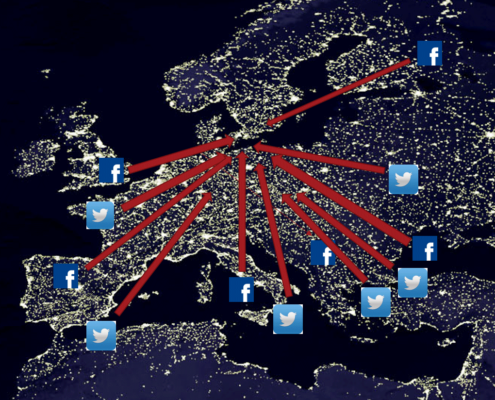
Campaign tested on both Facebook and Twitter
If you need to attract followers fast, make people aware of a specific event, or advertise, then promoting or boosting content can be a smart thing to do.
But which is best? Twitter or Facebook?
I got the opportunity to test this in connection with the European Conference for Science Journalists which took place in Copenhagen 26th-30th June 2017. Mike Young Academy took care of the outreach and social media for the conference.
One of my tasks was to make journalists in Europe aware of the conference. With a small budget for advertising I was therefore able to boost the same underlying content, promoting the conference on both Twitter and Facebook.
This allowed me to test, for a limited and clearly defined goal, the relative merits of the two social media platforms: I was able to see how many people clicked on to the underlying conference website ECSJ2017.com from each platform for each boosted campaign. And I could use web data measured via Google Analytics to estimate (via proxies like bounce rate etc.) the likelihood of the intended audience ultimately coming to the conference.
Three-step process
Finding out which platform performs the best is a three-step process, where I first compare the reach, then the engagement, then the quality of the traffic coming from each platform.
First the reach, or the number of people who see the content on their Twitter and Facebook news feeds:
I take the same underlying content, three different webpages on ECSJ2017.com (a survey, a travel grant and a registration deadline) and post it on Twitter and Facebook. I then use the same amount of money to boost or promote the content on each platform, trying to maximize the reach of the content, and targeting as specific as I can to science journalists in Europe.
Second step is comparing the engagement, or the number of clicks that each boost/promotion resulted in on the ECSJ2017.com website. I can measure this using Google Analytics.
Third step is estimating the quality of the engaged traffic, or the relative number of people who register for the conference as a result of clicking on the boost/promotion. For this I use a number of measures, but mostly rely on bounce rate. More on this later.
I can then evaluate which platform performs the best.
Reach – getting it out on to people’s feeds
Here below is an example of one of the posts I boosted on the ECJ2017 Twitter account.
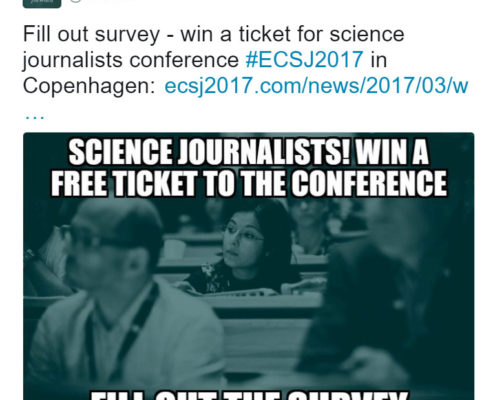
Tweet about a survey for #ECSJ2017 that was given a paid promotion.
I am trying to target the posts as specific as possible on science journalists in Europe.
Twitter offers a wide range of targeting options. I delimit the campaign to European countries and type in keywords like ‘science communication’ and ‘science journalism’. The idea is that Twitter matches your promotion with users’ profiles (and possibly the content of their tweets, Twitter does not say so).
Another interesting function is being able to match your promotion to people that you know on Twitter already. So I match the campaign to a few Twitter journalist profiles that already follow our profile and that have a good science journalism following already. The Twitter algorithm should then show my promotion to other profiles like them.
Balkans here we come
And it works!
Minutes after pressing ‘go’ on the promotion, the campaign is approved on Twitter and the traffic starts pouring in on the ECSJ2017 page, as can be seen on Google Analytics from all of the countries in Europe.
The targeting choices on Facebook are oriented towards consumer choices and lifestyle rather than interests.
After a couple of hours, I realized that we were mostly getting traffic from Southeastern Europe. This is fine, but I wanted to spread it out a bit, so I went in and edited out these countries from the promotion. The traffic then shifted to the rest of Europe.
What is happening here? My theory is that with the bidding system that Twitter uses, my tweet is showing predominantly to Southeastern European locations as it can show them at a lower price.
But with the adjustments, it worked again throughout Europe. 66,000 impressions and nearly 2,900 clicks within a few days, according to Twitter’s own system. This squares roughly with the traffic that I can verify on Google Analytics. I paid around DKK 0.2 per click or EUR 0.03 per click.
Now to Facebook. The Facebook post is below.
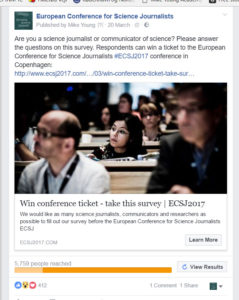
Post as used for the Facebook campaign for #ECSJ2017
The Facebook campaign has a harder time finding and targeting science journalists. The targeting choices on Facebook are oriented towards consumer choices and lifestyle rather than interests. But I set it up as good as I can, and pressed ‘go’. Strangely, and like Twitter, Facebook had a propensity to show my promoted content to Southeastern Europe.
The campaign garnered hundreds of likes, and even a few ‘heart’ emoticons. But few clicks. No matter what I tried, it appeared as if I ended up paying for ‘likes’ rather than clicks on to the webpage.
In the end it garnered 20 link clicks and more than a hundred page likes, and had me paying upwards of DKK 16 or EUR 2 per click, which seemed expensive.
Getting people to do stuff – engagement
“Are you a science journalist? Grants of up to EUR 600 for travel and accommodation in #ECSJ2017 in Copenhagen.”
This was the content of my second campaign, and by now I was learning the tricks.
Target the next Twitter campaign on countries, on keywords in profiles, and on users like the ones that follow you already. And be careful of the algorithm’s propensity to over-expose to Southeastern Europe.
It resulted in 76,000 impressions, got 3,400 clicks, at an average cost of DKK 0,20 or EUR 0,03 per click.
Facebook on the other hand, was still sluggish.
Facebook has a targeting function called ‘friends of friends’, and so I applied this. This means that the promoted post will be shown to anyone who is a friend of someone who already likes your page. The logic is, that if someone likes your page – say, a science journalist – then their friends are more likely to be science journalists.
To increase the pressure I subsequently promoted the same post using the so-called website tags function.
It was so much harder to reach people through Facebook, that the people we actually did reach were more likely to be interested in our conference.
Facebook, and Twitter, introduced website tags a few years ago. What it means is that you add a snippet of code to your website. Facebook and Twitter then target users in your promotions to people who are like the people who have visited your site already.
With this, more targeted, approach, Facebook started performing better. It reached more than 5,000 people, and got me 67 link clicks for a DKK 300 promotion, or around DKK 4.5 (EUR 0.6) per click.
But still, Twitter appears to be blasting away from Facebook.
Only people who are really interested, matter
Here is a table showing an aggregate of the promoted posts with their reach or number of impressions, the number of clicks generated for each platform, the costs per click, and the bounce rate (more about bounce rate below).
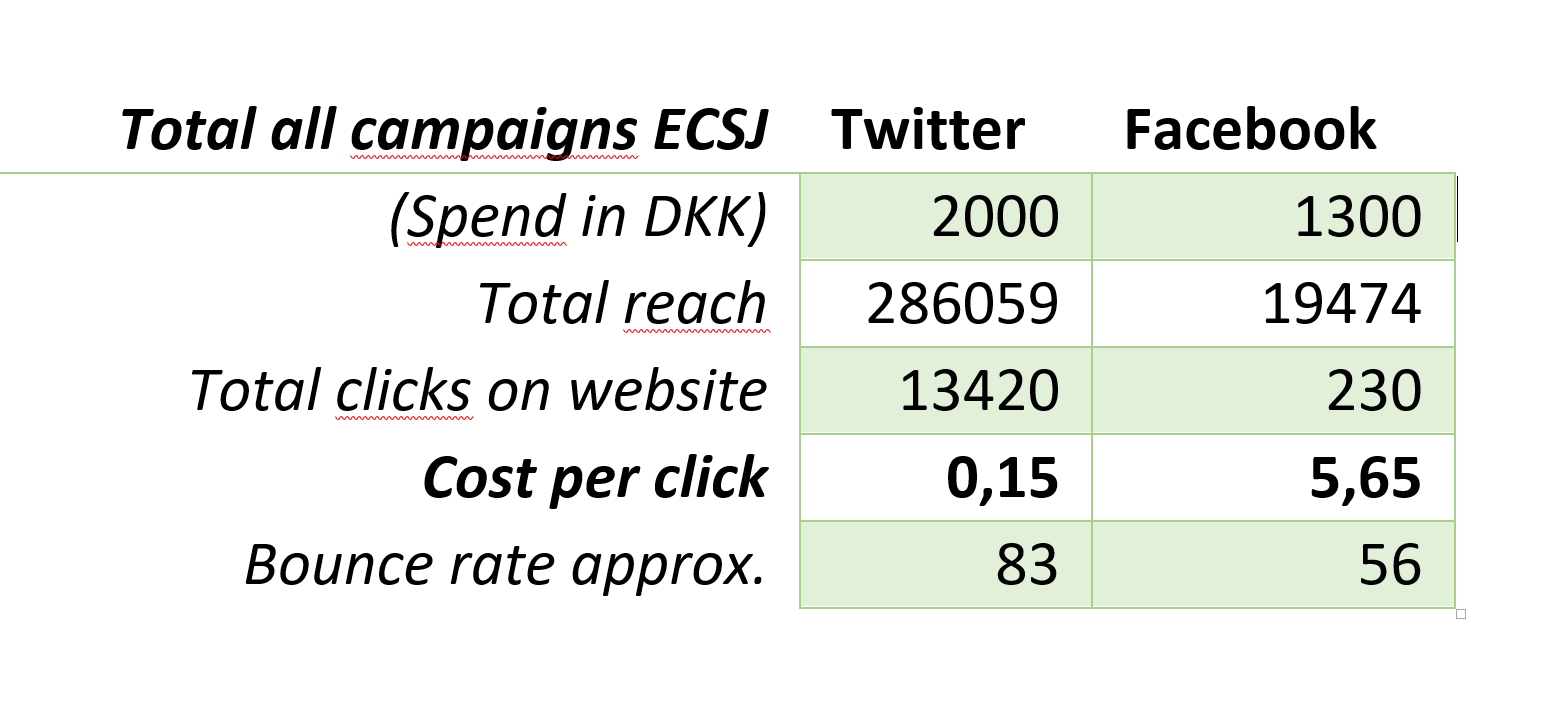
Facebook vs Twitter for selected ECSJ campaigns
So we now know that Twitter is outperforming Facebook considerably. But what about the quality of the traffic generated? Is there more likelihood that the people coming through to your website from Facebook actually do something on your website, like register to the conference?
This is a hard question to answer, and could only be definitively answered if we had website tags set up throughout the conference registration process, so that I could follow users from Twitter/Facebook on to the ECSJ2017 site, then on to the separate registration site, and then exiting with a confirmed registration. This was not possible for us.
Difficult to verify
But there are other ways to measure the quality of incoming traffic. The ‘bounce rate’ is the percentage of people that enter your webpage and then exit without clicking on to another page on your site. The bounce rate can be used as a proxy for quality: People who are genuinely interested, and who come to your web page through a promotion will want to find out more by clicking on to other pages on your site. People who are not interested, or who have entered your web page by mistake, will leave right away.
The bounce rate for all the traffic coming in through our Twitter campaigns was in the range of 80 per cent. That means that 80 per cent of all the users who entered the page left again without clicking further on the site. Facebook did better here. The low traffic numbers on Facebook meant that there is room for statistical error, but Facebook traffic had bounce rates ranging from 39-60 per cent.
On balance, the quality of the Facebook campaign traffic that I did get was better. My interpretation is that it was so much harder to reach people through Facebook, that the people we actually did reach were more likely to be interested in our conference.
By now you will realise which platform has won this contest overall though. Twitter outreached and then out-clicked Facebook by factors of up to 100. Even if you correct for a lower bounce rate on Facebook showing higher quality, Twitter gave us far more value for money.
On top of this, the promotion process on Facebook is complicated: It is hard to work out exactly how many paid clicks you have received for each paid promotion, and it can take ages (in one case, 22 hours) to get your promotion approved by the Facebook moderators.
Pears and bananas
Now the disclaimers. Comparing Facebook and Twitter is, of course, like comparing pears and bananas.
First, Twitter and Facebook work differently and it is impossible to target users on the platforms in the same way. But my contention is, that if I maxed out on my own attempt to target the audience on each platform, to the best of my ability, I would at least prove something.
Second, the likelihood that Twitter will win this contest is greatly increased by the fact that Twitter is the social media of choice for journalists.
So look at this as a case study in the promotion of content up to a conference event.
The data may, or may not, have relevance for other fields. But even I was surprised to see the numbers!
Should I have promoted the content differently on each platform? Are there better ways to measure the quality of the traffic? Have I made a big mistake? Please let me know! I am interested to hear any comments you may have!
Be a social media influencer! Here is my Twitter course for communicators, researchers and experts. See Mike Young Academy services here.

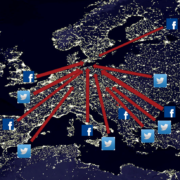


What an interesting case study! My first thought when I started reading was, “Journalists are all over Twitter.” Glad you mentioned that at the end. SMM usually follows the same course: start with best practices, experiment, alter and repeat. I’m curious to know whether you see similar results next year. A lot can change online in 12 months.
I wonder if you’d have better luck with Facebook engagement through a boosted post rather than a standard ad, and maybe through creating an event page on Facebook. At first, I didn’t like event pages much because you want people to visit your site so you can capture their data (like email) and add it to your database. But after some experience with event pages, my opinion is evolving. When people say they’re “interested” in an event on FB, it shows up in their friends’ feeds and you reach people you might not have otherwise.
Thanks for your feedback Lindsey! The Facebook campaigns were all, actually, what they call ‘boosted’ posts. The same posts were boosted three times, each time at a more specific level of targeting, with the last one using website tags. As for the events pages, we have not had so much luck with them so far, for the reasons you mention. But I plan to work on them, and give them another try!